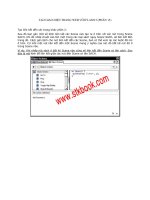GIÁO TRÌNH MARKETING NGHIÊN CỨU - PHẦN 15 docx
Bạn đang xem bản rút gọn của tài liệu. Xem và tải ngay bản đầy đủ của tài liệu tại đây (297.22 KB, 18 trang )
Basic Data Analysis:
Descriptive Statistics
Ch 15 2
Coding Data and the Data Code
Book
•
Data entry refers to the creation of a
computer file that holds the raw data
taken from all of the questionnaires
deemed suitable for analysis
•
Data coding refers to the identification
of codes that pertain to the possible
responses for each question on the
questionnaire
•
Data code book identifies all of the
variable names and code numbers
associated with each possible
response to each question that makes
up the data set
Ch 15 3
Ch 15 4
Types of Statistical Analyses
Used in Marketing Research
•
Data summarization: the process of
describing a data matrix by
computing a small number of
measures that characterize the data
set
Ch 15 5
Types of Statistical Analyses
Used in Marketing Research
•
Four functions of data
summarization:
–
Summarizes the data
–
Applies understandable
conceptualizations
–
Communicates underlying patterns
–
Generalizes sample findings to the
population
Ch 15 6
Why is Statistical Analysis
Used?
•
Why Use Statistical Analysis?
–
To summarize data
•
The average price of a Gateway PC
is $2,489
•
The low is $999, and the high is
$4,678: this is the range
•
The mode is $2,200
Ch 15 7
Why is Statistical Analysis
Used?
•
Why Use Statistical Analysis?
–
To show basic patterns in the data
•
30% buys at $1,500 or less
•
50% buys at between $2,500 and
$1,500
•
20% buys at $2,500 or more
Ch 15 8
Why is Statistical Analysis
Used?
•
Why Use Statistical Analysis?
–
To interpret these patterns
•
The majority of Gateway buyers pay
$2,500 or less
Ch 15 9
Why is Statistical Analysis
Used?
•
Why Use Statistical Analysis?
–
To generalize the patterns to the
population
•
95% of all Gateway buyers pay
between $2,000 and $3,000 for their
PC’s
Ch 15 10
Types of Statistical Analyses
Used in Marketing Research
•
Statistical Analysis:
Ch 15 11
Types of Statistical Analyses
Used in Marketing Research
•
Five Types of Statistical Analysis:
1. Descriptive analysis: used to
describe the data set
2. Inferential analysis: used to
generate conclusions about the
population’s characteristics based
on the sample data
Ch 15 12
Types of Statistical Analyses
Used in Marketing Research
3. Differences analysis: used to
compare the mean of the
responses of one group to that of
another group
4. Associative analysis: determines
the strength and direction of
relationships between two or
more variables
Ch 15 13
Types of Statistical Analyses
Used in Marketing Research
5. Predictive analysis: allows one to
make forecasts for future events
Ch 15 14
Understanding Data Via
Descriptive Analysis
•
Two sets of descriptive measures:
–
Measures of central tendency:
used to report a single piece of
information that describes the most
typical response to a question
–
Measures of variability: used to
reveal the typical difference
between the values in a set of
values
Ch 15 15
Understanding Data Via
Descriptive Analysis
•
Measures of Central Tendency:
–
Mode: the value in a string of numbers
that occurs most often
–
Median: the value whose occurrence lies
in the middle of a set of ordered values
–
Mean: sometimes referred to as the
“arithmetic mean”; the average value
characterizing a set of numbers
Ch 15 16
Understanding Data Via
Descriptive Analysis
•
Measures of Variability:
–
Frequency distribution reveals the
number (percent) of occurrences of each
number or set of numbers
–
Range identifies the maximum and
minimum values in a set of numbers
–
Standard deviation indicates the degree
of variation in a way that can be
translated into a bell-shaped
curve distribution
Ch 15 17
Understanding Data Via
Descriptive Analysis
•
Measures of Variability:
Ch 15 18
When to Use a Particular
Statistic









